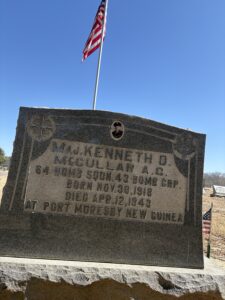Panola’s Most Decorated – Major Kenneth McCullar marker unveiling Saturday in Little Park
Published 8:34 am Wednesday, March 12, 2025
Almost 82 years after he was killed in a strange accident while serving in New Guinea, Panola County’s most decorated soldier will be memorialized with a Mississippi Historical Marker at the Little Park in Pope this Saturday.
Major Kenneth Dalton McCullar, born Nov. 30, 1918, on a farm owned by his parents located between present day Plum Point and Chickasaw Point on the north side of the Enid reservoir, will have a marker dedicated to his life and service by friends and family in a short ceremony that will begin at 11 a.m. at the park on Magnolia St.
Kent Rowsey, a cousin of the famed airman, said his siblings sponsored the marker to forever ensure the service and heroics of Major McCullar are preserved in the county for future generations.
Trending
“When our parents passed away we realized it was up to us to make sure this part of the county’s history, and our family history, wouldn’t be forgotten,” Rowsey said. “We are excited to have the marker unveiled.”
McCullar was awarded numerous aviation medals for his remarkable bombing missions in the last seven months of his life, but the five most important medals were not presented until after his untimely death.
That presentation took place at the Air Force base in Grenada when a full Colonel sent from Washington gave Mr. and Mrs. D.W. McCullar five prestigious medals in a ceremony marking their son’s passing the year before. Newspapers at the time said it was the largest number of medals ever presented to one soldier, or his survivors, in the history of the U.S. Military.
Those medals were the Distinguished Service Cross, Silver Star with three Oak Leaf clusters, Distinguished Flying Cross with one Oak Leaf cluster, Purple Heart, and the Air Medal with two Oak Leaf clusters.

At Saturday’s ceremony, those very medals will be on display for public viewing, Rowsey said.
Trending
A short history of the life of Major McCullar is recorded in The Panola Story. Excerpts follow.
Kenneth finished grade school at Pope at age 11, having skipped two grades. He finished high school at Pope in 1934 at age 15. He entered Mississippi State College in 1934 with just the clothes he could carry and $50, taking campus jobs to pay his tuition.
He worked summer jobs, including helping build the dam for the Sardis reservoir, transferred to Mississippi College and graduated in 1938 at age 19. He taught math and coached football at Forest High School, and joined the Army Air Corps for flight training.
Kenneth was working in a Panola County cotton field when he got the letter informing him of his acceptance as an aviation cadet with orders to report to Love Field in Texas in June 1939. He completed basic flight training at Randolph Air Force Base and moved to Kelly Field in San Antonio for advanced training.
He was commissioned on May 11, 1940 as a second lieutenant and sent to guard the Panama Canal Zone. His flight assignments soon included Puerto Rico, Guatemala, Nicaragua, and other Latin American countries with his 3rd Bomb Squadron.

By February of 1943 he had been promoted to Major and began his remarkable run of successful bombing missions that drew praise from across the wartime aviation fraternity. McCullar developed a style referred to as “skip bombing” that involved him flying very fast and very low and hitting multiple warships in the Pacific Theatre.
His attacks and destruction of Japanese destroyers and cargo ships was unmatched. One of several examples was an outstanding performance in the Battle of the Bismark Sea where his squadron sunk or beached 15,000 Japanese troops and all of the enemy soldiers were drowned or killed with weapons.
The last seven months of his life, McCullar completed missions that are still highlights of Air Force history in the raging months of WWII.
Tragedy struck on April 12, 1943, when he was just 24 years old.
He had flown 68 combat missions involving 460 combat flying hours when his Flying Fortress prepared to lift off for a night mission in Port Moresby, New Guinea. On takeoff, a kangaroo ran across the runway and got tangled in the wheel of the heavy bomber. The impact caused hydraulic lines to break and ignite, setting the plane on fire and exploding its bomb load.
McCullar and his entire crew perished in the explosion. Informed of Major McCullar’s death, General George C. Kenney, Southwest Pacific AAF commander, said:
“I not only had a high regard for Kenneth McCullar as a pilot, but personally I was very fond of him. His loss was a distinct blow to his organization, the Fifth Air Force, and to me personally. We can’t afford to lose men of his caliber. Not only was he one of the most skillful pilots but he was a natural born leader. His men liked to follow him. He was a master craftsman at the art of sinking Japanese vessels.”

McCullar was buried with his men in Port Moresby and a memorial service was held in the Batesville High School auditorium on Sunday, May 2, 1943. Following the war, his body was returned to the United States and final rites were held at Batesville Methodist Church. His final resting place is the Batesville Magnolia Cemetery, on the Eureka Road side.
Military pallbearers at the service included Norris Wray, Louie Darby, C.E. Flint, Jr., James C. Barnum, Malcolm Seale, and Stovall Tidwell.
Eight former teachers and classmates were honorary pallbearers, including, L.S. Davidson, R.C. Carlisle, Harris Hubbard, James H. Moore, D.A. Williams, Sgt. Alton Hill, Davis Pou Bell, and William Marshall.






